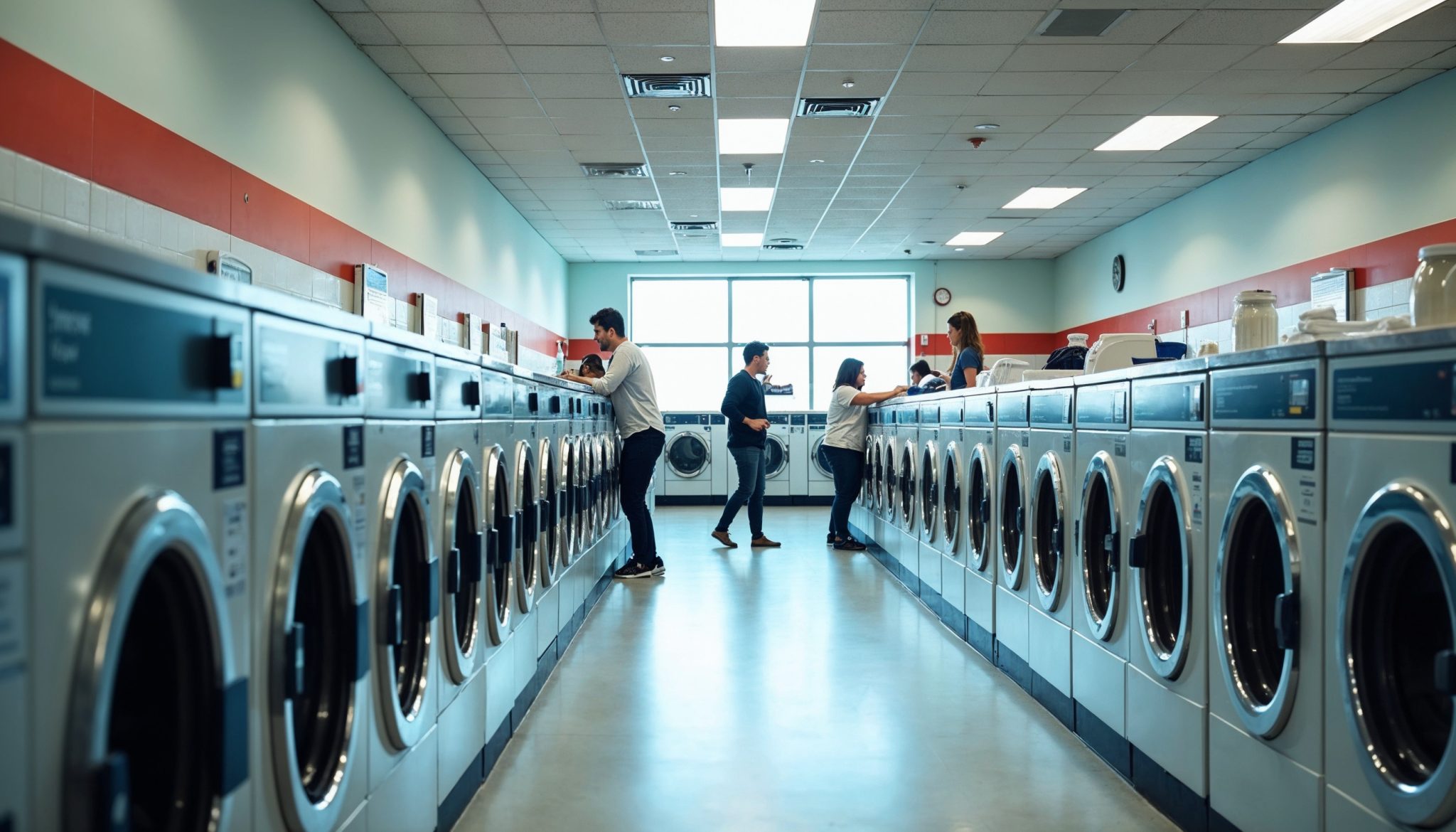Laundromats have long been a fixture in American communities, offering convenient self-service laundry options and, increasingly, additional services such as wash-and-fold or pick-up and delivery. While the laundromat industry might appear straightforward at first glance, a closer look reveals a dynamic sector heavily influenced by factors such as rental housing trends, urbanization, and shifting consumer demands. Below is a comprehensive, data-driven exploration of U.S. laundromat demographics—who uses them, where they’re located, and how the industry continues to evolve.
1. The Size and Scope of the U.S. Laundromat Industry
Market Size and Revenue
- Annual Revenue: The U.S. laundromat industry generates an estimated $5 billion per year.
- Steady Demand: Laundromats are often viewed as recession-resistant businesses because people require clean clothes regardless of economic conditions.
Number of Locations
- 30,000–35,000 Laundromats: Across urban, suburban, and rural areas, there are an estimated 30,000 to 35,000 facilities in operation.
- Local Competition: High-density urban areas can have numerous laundromats within a short radius, while rural communities might share a single facility.
Ownership Structure
- Independent Businesses: Most laundromats in the U.S. are owned and operated by small-business owners, rather than large franchise chains.
- Entrepreneurial Appeal: The relatively stable revenue model attracts new entrepreneurs. However, location and local demographics significantly impact profitability.
2. Where Laundromats Thrive: Geographic Distribution
Urban vs. Suburban vs. Rural
- Urban Centers
- High Rentership: Cities like New York, Chicago, Los Angeles, and San Francisco have dense populations of renters, which increases the demand for laundromats.
- Limited In-Unit Facilities: Many urban dwellings, especially older buildings, don’t include in-unit washers and dryers, making laundromats essential.
- Suburban Areas
- Growing Opportunities: As more multi-family housing is built in suburban areas, laundromats in these regions serve both renters and small businesses (e.g., spas, daycare centers).
- Less Density: Compared to cities, suburban laundromats are more spread out, but still benefit from consistent neighborhood usage.
- Rural Communities
- Community Hubs: In many small towns, the local laundromat may be one of the few commercial services available, acting as a gathering place.
- Lower Volume: Rural facilities generally see fewer daily customers but remain vital for residents without reliable in-home appliances.
Regional Breakdown
- Northeast
- High concentration of renters and dense urban areas (e.g., New York City, Philadelphia). Some estimates suggest 25–30% of U.S. laundromats operate in this region.
- Midwest
- Metropolitan areas such as Chicago and Detroit house a significant number of laundromats. Smaller Midwestern towns often have at least one laundromat serving multiple counties.
- South
- States like Texas and Florida are seeing sustained population growth, driving increased demand for laundry services. A mix of urban centers and large suburban areas fosters robust laundromat activity.
- West Coast
- California leads with some of the highest counts of laundromats, especially in Los Angeles County. The state’s competitive housing market often results in limited in-unit laundry, thus boosting laundromat usage.
3. Who Uses Laundromats: Key Demographics
Renters vs. Homeowners
- Renters
- Estimated 60–80% of laundromat customers are renters who lack in-unit laundry or have limited access to shared facilities.
- Urban apartment dwellers can make up 90% of users in certain neighborhoods.
- Homeowners
- While less common, homeowners utilize laundromats for large items like comforters or area rugs.
- Temporary needs—such as washer/dryer repairs—also bring homeowners in.
Income Levels
- Median Household Income
- Laundromat users often fall into the $20,000–$50,000 annual income range, although geographic and regional variations exist.
- Lower- to middle-income households rely heavily on coin- or card-operated laundry facilities, but higher-income individuals may also use drop-off or pick-up services for convenience.
- Cost-Conscious Customers
- Consolidating loads and looking for promotions are common behaviors, reflecting the budget-minded approach of many laundromat patrons.
Age Groups
- Young Adults (18–34)
- College students and young professionals living in dorms or shared apartments make up a significant user base.
- Convenience and speed are top priorities.
- Middle-Aged Adults (35–54)
- This demographic includes long-term renters and small business owners needing commercial-grade capabilities (e.g., for linens or uniforms).
- Seniors (55+)
- Seniors living in apartments or communities without laundry facilities often rely on laundromats.
- Wash-and-fold services can be particularly appealing to those who prefer a more hands-off approach.
Family Size
- Single Occupants & Couples
- Typically smaller weekly loads but may do laundry more frequently to maintain work or social wardrobes.
- Families with Children
- Larger, more frequent loads, often completed on weekends.
- Commercial machines capable of handling 20–80 pounds are particularly helpful for families needing quick, high-volume washes.
4. Behavioral Insights: Frequency, Peak Times, and Motivations
Frequency of Visits
- Weekly or Bi-Weekly
- Most laundromat customers do one or two major laundry sessions per week.
- Smaller families or singles might visit more frequently to avoid large accumulations of clothes.
- Peak Days
- Sundays typically witness the highest foot traffic, followed by Saturdays.
- Weekday evenings can also be busy with working professionals who do their laundry after regular business hours.
Reasons for Using Laundromats
- Lack of In-Unit Laundry
- The most common reason, particularly in older urban buildings.
- Bulk or Specialty Loads
- Items like comforters or curtains may be easier to clean using large-capacity commercial machines.
- Temporary Need
- During home appliance repairs or while relocating, people use laundromats on a short-term basis.
- Traveler/Tourist Usage
- In areas with many short-term rentals (e.g., Airbnb), visitors may rely on local laundromats.
Service Add-Ons
- Wash-and-Fold
- Popular among busy professionals, parents, and seniors who want to drop off laundry and pick it up folded and ready to put away.
- Pick-Up and Delivery
- Frequently offered in urban markets, it attracts higher-income clients or those without transportation.
- Commercial Accounts
- Small businesses like restaurants, salons, and bed-and-breakfasts outsource their laundry for efficiency.
5. Technology and Cultural Shifts
Payment Systems
- From Coins to Cards and Apps
- Many laundromats now adopt card-operated or mobile-app payment platforms.
- Cashless options reduce theft, simplify revenue tracking, and appeal to tech-savvy users.
- Mobile Integration
- Apps allow customers to see machine availability, check load progress, and pay digitally.
- Younger generations, especially students, tend to prefer these modern conveniences.
Amenities and Community
- Wi-Fi and Comfortable Seating
- Laundromats increasingly offer Wi-Fi, ample seating, and even televisions to create a more pleasant waiting experience.
- Kids’ Play Areas
- Family-friendly corners help parents manage children while completing laundry.
- Hybrid Services
- Some laundromats double as cafés or convenience stores, turning the space into a local social hub.
Impact of the Pandemic
- Enhanced Cleaning Protocols
- Focus on sanitization and social distancing heightened during COVID-19, attracting safety-conscious customers.
- Contactless Drop-Off
- Demand for wash-and-fold and delivery services rose, appealing to those avoiding crowded public spaces.
6. Looking Ahead: Trends and Outlook
Urbanization and Renting
- Continued Growth in Cities
- Ongoing urban migration and a high rental population indicate stable demand for laundromats in metropolitan areas.
- Increasing Rentership
- The renter population in the U.S. has been on the rise, expanding the laundromat customer base.
Service Diversification
- New Revenue Streams
- Beyond self-service, owners are adding wash-and-fold, dry cleaning drop-off, and pick-up/delivery to attract a broader range of customers.
- Appealing to Higher Incomes
- Convenience-oriented services can bring in professionals willing to pay premiums for time savings.
Sustainability
- Eco-Friendly Equipment
- New commercial washers are designed to reduce water and energy consumption.
- Green Marketing
- Laundromats advertising sustainable practices often attract environmentally conscious clientele.
Conclusion
The U.S. laundromat industry is both resilient and responsive to changing demographics, economic fluctuations, and technological innovations. With an estimated $5 billion in annual revenue and 30,000–35,000 locations nationwide, laundromats serve a diverse range of customers—primarily renters, but also families, homeowners needing specialty loads washed, and small businesses. Geography plays a critical role, with urban centers typically hosting the densest clusters of laundromats.
Understanding the who, where, and why of laundromat usage can help current and prospective owners tailor their services. By investing in modern payment systems, amenities, and value-added services—such as wash-and-fold or delivery—laundromats can diversify their revenue streams and better meet consumer demand. As more Americans move into cities and rental rates continue to climb, the outlook for innovative, customer-focused laundromats remains highly promising.








